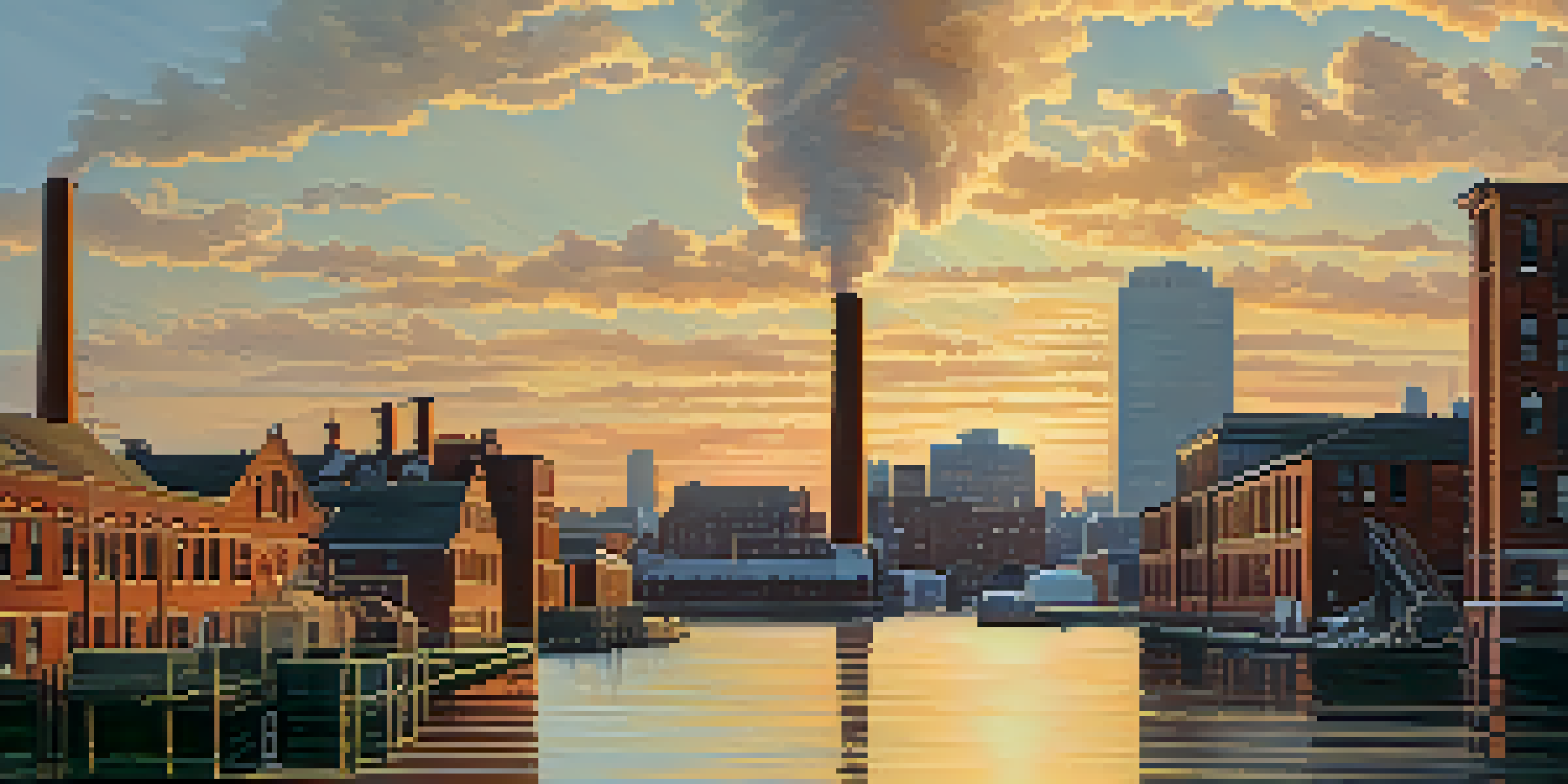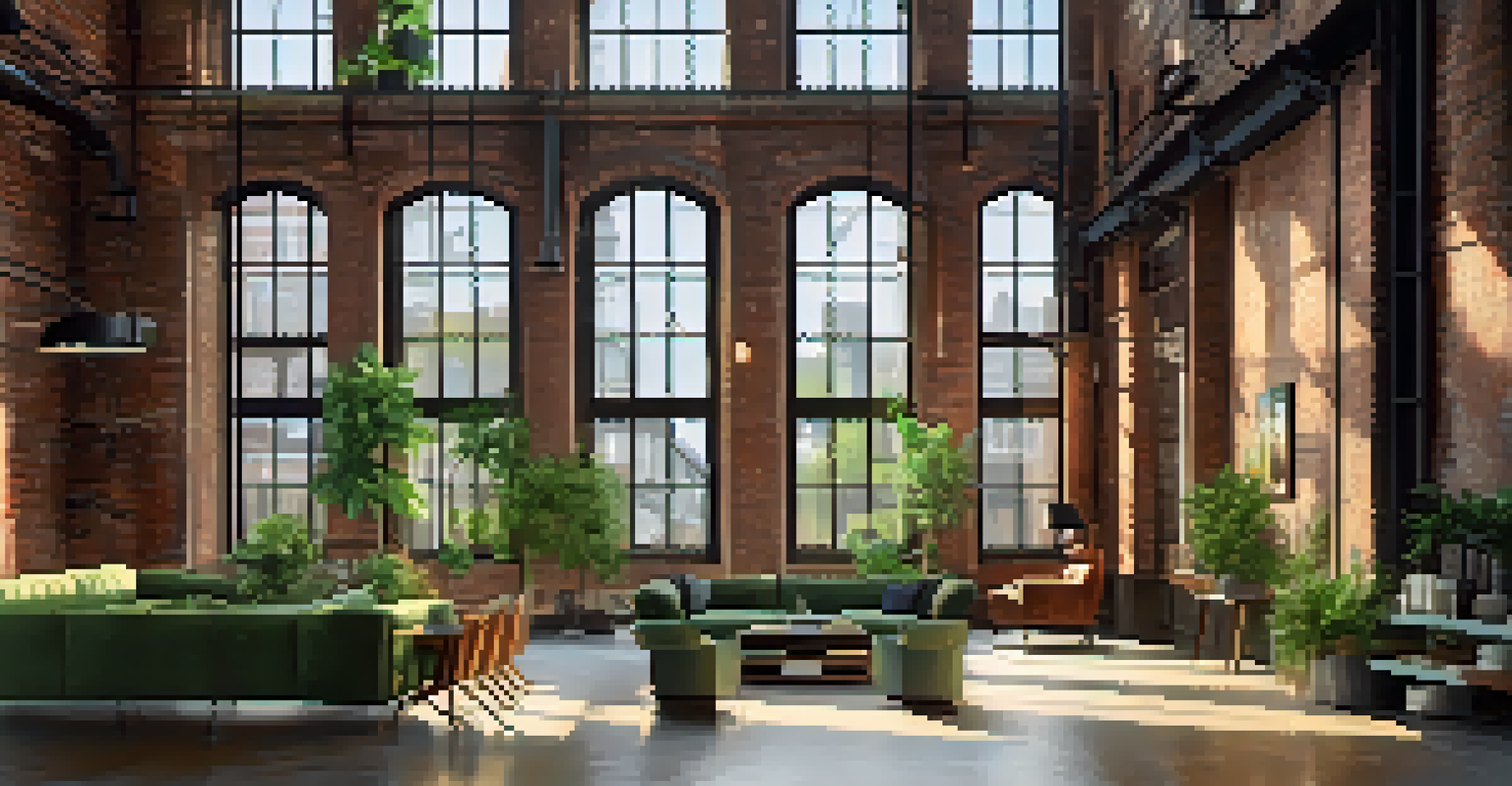Understanding the Role of Industrial Architecture in Boston

What is Industrial Architecture and Its Importance?
Industrial architecture refers to the design and construction of buildings that are primarily used for manufacturing and production purposes. This type of architecture plays a crucial role in shaping the industrial landscape of cities, influencing both their economy and culture. In Boston, this means blending functionality with aesthetic appeal, creating structures that are not only efficient but also visually engaging.
Architecture is the thoughtful making of space.
Historically, industrial architecture has been a key driver of economic growth in urban areas. In Boston, the legacy of the Industrial Revolution brought about a surge in factories and warehouses, which transformed the city’s skyline. These buildings often feature robust materials and practical designs, reflecting the needs of the industries they serve while contributing to the city's unique character.
Understanding industrial architecture is essential for appreciating how it impacts urban development. It offers insights into the past, indicating how industries shaped communities and economies. Moreover, recognizing the role of these structures can foster a greater appreciation for preservation efforts and adaptive reuse in modern urban planning.
Historical Context of Boston’s Industrial Architecture
Boston's industrial architecture is deeply rooted in its historical context, particularly during the Industrial Revolution. As factories sprang up along the waterfront and throughout the city, they became symbols of progress and economic opportunity. Notably, buildings like the Boston Rubber Shoe Company exemplified the architectural style of the era, featuring large windows and open spaces conducive to manufacturing.

The city’s industrial buildings were not just functional; they also showcased the craftsmanship and materials of the time. Many of these structures were constructed using brick and iron, materials that conveyed durability and strength. This architectural style not only served practical purposes but also made a statement about the city’s aspirations and industrial prowess.
Role of Industrial Architecture
Industrial architecture shapes Boston's economy and culture by integrating functionality with aesthetic appeal.
As time passed, the demand for industrial space evolved, leading to various architectural adaptations. Today, many of the original industrial buildings have been repurposed for modern uses, blending historical significance with contemporary needs. This evolution reflects Boston’s ability to adapt while honoring its rich industrial heritage.
Key Features of Industrial Architecture in Boston
Industrial architecture in Boston is characterized by several distinct features that reflect its functional purpose. High ceilings and open floor plans were designed to accommodate large machinery and workflows, allowing for efficient production. Large windows were also a hallmark, providing natural light and ventilation, which were essential in factories and warehouses.
The best way to predict the future is to invent it.
The use of robust materials like steel, brick, and concrete speaks to the durability required in industrial buildings. These materials not only support the weight of heavy machinery but also contribute to the overall aesthetic, giving many structures a rugged, utilitarian charm. This blend of form and function is a defining characteristic of Boston's architectural landscape.
Additionally, many industrial buildings in Boston showcase unique architectural details, such as smokestacks and loading docks, which reflect their historical uses. These features serve as reminders of the city’s industrious past and enhance the visual interest of the urban environment. Together, they create a distinctive sense of place that honors Boston’s industrial roots.
The Impact of Industrial Architecture on Boston’s Economy
The industrial architecture of Boston has had a significant impact on the city’s economy over the years. Originally, these structures facilitated manufacturing and production, providing jobs and supporting local businesses. As industries evolved, the adaptability of these buildings allowed for new economic opportunities, including tech startups and creative spaces.
Today, the adaptive reuse of industrial buildings is a thriving trend in Boston, where former factories have been transformed into luxury apartments, offices, and cultural venues. This not only preserves the historical fabric of the city but also stimulates economic growth by attracting new residents and businesses. The revitalization of areas like the Seaport District is a prime example of this economic transformation.
Preservation and Adaptation
Efforts to preserve and adapt industrial buildings are vital for maintaining Boston's historical identity while meeting modern needs.
Moreover, the presence of these unique architectural spaces contributes to Boston’s appeal as a destination for tourists and new residents alike. The blend of history and modernity in industrial architecture creates a vibrant urban atmosphere that encourages exploration and investment. This ongoing evolution highlights the vital role that industrial architecture plays in Boston’s economic landscape.
Preservation Efforts for Industrial Architecture in Boston
Preserving Boston's industrial architecture is essential for maintaining the city’s historical identity. Various organizations and local governments are actively working to protect these structures from demolition and neglect. Initiatives like the Boston Landmarks Commission help ensure that significant buildings are recognized and preserved for future generations.
Adaptive reuse projects have become a popular method for preserving industrial buildings while giving them new life. By repurposing these structures into residential, commercial, or public spaces, cities can retain their historical significance while meeting contemporary needs. This approach not only conserves architectural heritage but also fosters community engagement and revitalization.
However, preservation is not without its challenges. Balancing the needs of modern development with historical conservation can be complex, often requiring careful planning and community input. Successful preservation efforts in Boston demonstrate the importance of collaboration among stakeholders, showcasing how a city can honor its past while embracing its future.
Modern Adaptations of Industrial Architecture in Boston
As Boston continues to evolve, the modern adaptations of industrial architecture reflect contemporary trends and lifestyle changes. Many former factories and warehouses have been transformed into trendy lofts, coworking spaces, and cultural hubs, blending historical charm with modern amenities. This transformation not only breathes new life into old buildings but also enhances the urban experience for residents and visitors alike.
The integration of green design principles into these adaptations is also notable. Many converted industrial spaces now feature sustainable technologies, such as energy-efficient systems and green roofs, aligning with Boston’s commitment to environmental sustainability. This fusion of old and new demonstrates how industrial architecture can be both functional and environmentally responsible.
Future Trends in Urban Design
The future of industrial architecture in Boston will focus on sustainability and innovation as the city addresses urban challenges.
Moreover, these modern adaptations create a unique sense of place that attracts diverse communities. By revitalizing industrial areas, Boston fosters a dynamic urban landscape that celebrates its history while promoting innovation and creativity. This ongoing transformation showcases the potential of industrial architecture to adapt and thrive in a modern context.
The Future of Industrial Architecture in Boston
The future of industrial architecture in Boston is poised for exciting developments as urban needs continue to evolve. As the city grapples with challenges like housing shortages and climate change, the potential for repurposing existing industrial buildings becomes even more critical. This trend not only preserves historical character but also addresses pressing urban issues through innovative design solutions.
Emerging technologies and sustainable practices are likely to play a significant role in shaping the future of these structures. As architects and developers explore new ways to enhance energy efficiency and reduce environmental impact, industrial buildings will continue to adapt to contemporary standards. This evolution presents an opportunity for Boston to lead in sustainable urban development.

Ultimately, the future of industrial architecture hinges on collaboration among city planners, developers, and the community. By embracing the past while looking ahead, Boston can create a harmonious balance that honors its industrial roots and fosters a vibrant, sustainable urban environment. The ongoing dialogue about the role of industrial architecture will be crucial in shaping the city’s identity for generations to come.